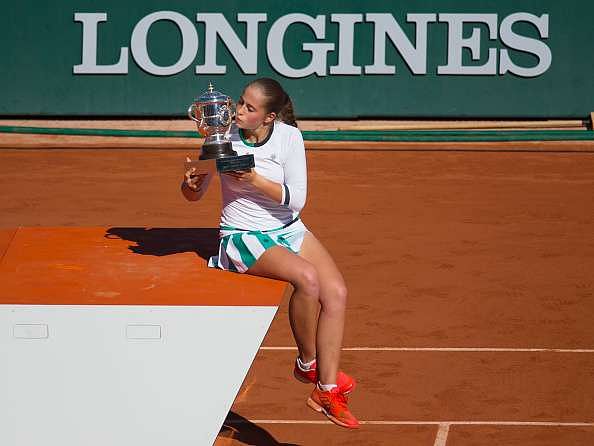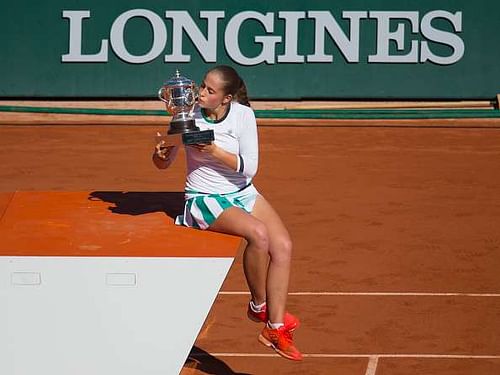
Jelena Ostapenko's French Open win was everything you'd want a maiden Slam triumph to be

Jelena Ostapenko stunned her fancied opponent to clinch the French Open title
When an unheralded player storms through the draw to win a Grand Slam against all odds, you try to remember specific moments during the run that prophesized the stunning final result. That tough hold from two break points down in the second round – surely that was the turning point. That forehand winner on the run at 5-5 in the tiebreaker – everything changed from there! That in-your-face scream of “Come on!” after upsetting the tournament favourite – how could we not know she'd win the whole title from there?
In Jelena Ostapenko's case though, the moment was spelt out for us, in clear and unambiguous words. After losing to her in the third round, Lesia Tsurenko said that Ostapenko could win the tournament if she continued playing the way she was playing. If only we had listened to Tsurenko.
But it’s not just the winning moments or the signs of impending greatness that remain in memory from a Grand Slam title run – especially not when it’s a 20-year-old doing all the winning. Ostapenko gave us plenty of moments to remember even when she wasn’t belting the ball into oblivion.
Throughout the tournament, Ostapenko expressed herself animatedly whenever she missed a shot. Sometimes she’d throw her head back and laugh, as though she had just cracked a hilarious joke. Other times she’d stare at the line in disbelief, as though she couldn’t believe her bad luck (even if the ball had missed the line by two metres).
She also struggled to keep her emotions to herself whenever there was a contentious line call. At one point during her quarterfinal match, she called the umpire to check the mark off a Wozniacki shot that she was convinced had landed out. When the umpire insisted that she was looking at the wrong mark, Ostapenko’s mouth widened into a perfect ‘O’, which was followed by a perfect eye-roll. To her, the umpire’s judgment defied belief.
But the real surprise was that the Latvian never let any kind of negative emotion linger. Every time she made a wild error or was overruled by the umpire, she let out her frustration, but then also quickly regrouped and focused on the next point. It was almost like her youth and free-spiritedness kept peeking out, but she caught herself just in time and made the mature decision to move on.
That self-control helped her immensely during the final too. She started out like a demon, firing winners all over the court and breaking Halep to love in the very first game. This was the fearlessness of youth in its most liberating form, and it erased any kind of nervousness she was bound to feel at playing on such a big stage for the first time.
Almost inevitably though, the rockets that were finding the lines started missing them. She got broken right back and eventually lost the first set through a rash of unforced errors – 26 of them.
She then went down 3-0 in the second set, and it seemed like the fairytale was going to get over in a hurry. Halep had seen this kind of player too many times in her career; in fact, she had defused all of Karolina Pliskova’s power in just the previous round. She knew how to coax mistakes out of first-strike big hitters, and Ostapenko was obliging with a whole bunch of them.
But the Dr. Jekyll and Mr. Hyde sides of Ostapenko came into display again at that crucial stage, and everything changed. “I just told myself to enjoy the game and fight for every point,” Ostapenko said later when asked how she had turned the match around from such a hopeless situation.
“Enjoy the game” and “fight for every point” are actually two contrasting ideas. While some people might enjoy a struggle, you don’t normally associate hard work and toil with ‘fun’. Was Ostapenko really enjoying her game with a nothing-to-lose mentality, or was she determined to remain in the match by whatever means necessary?
It may have been one alternating with the other. She brought out huge fist-pumps after some of the points she won, but she also aimed for the lines with careless abandon. She saved break points with some of her most intelligent serving of the tournament, but she also squandered break points by sending returns sailing into the sky.
Halep later said that Ostapenko was either hitting her shots right on the line or missing them by metres. “At times I was just a spectator,” the Romanian lamented as she sought to dissect the loss in a painful press conference.
By the end, Halep the spectator had the best seat in the house to witness her opponent’s full-throttle Stan Wawrinka moment. Ostapenko’s mature side finally seemed to have won over, and she became more measured with her hitting. But since she is blessed with so much power, and such great technique, that actually made her infinitely more dangerous.
It was a display the like of which we have rarely seen in women’s tennis, let alone in a Slam final. It seemed like Ostapenko could blast the ball anywhere she wanted, and that too with perfect control. She angled her backhand wide to open up the court, fired her forehand down the line to wrong-foot one of the speediest players on tour, and even hit swing volleys from close to the baseline.
She wasn’t going for wild, hit-and-pray-for-the-best swings anymore. Instead, she was working the points like a veteran, making the ball sing to her tune. Whenever she wanted a point, whenever she needed a point, she could construct a brilliant point and end it with a winner conjured out of thin air.
Maybe her looks of disbelief at missing her shots were actually justified. When she’s on her game, as she was in the second half of today’s match, she almost can’t miss.
The spectators, a majority of whom were Halep fans waving Romanian flags, could scarcely believe what they were seeing. They had been screaming “SI-MO-NA! SI-MO-NA! SI-MO-NA!” all through the match, but those chants started lowering in intensity and volume as the Ostapenko Show took centre-stage. Meanwhile, the small group of fans cheering for the Latvian started matching them with their own chants of “JE-LE-NA! JE-LE-NA! JE-LE-NA!”
As the match hurtled towards the end at break-neck speed, frantic messages were exchanged by watchers everywhere. “She’s not cooling down!” I messaged one of my friends as Ostapenko uncorked another winner. “SHE’S GOING TO WIN!” came the startled reply.
I’d be lying if I said I wasn’t a little punch-drunk as Ostapenko’s final winner – her 54th – won her the match. It had all turned around so quickly, and with such decisive force, that we had very little time to react. But not Ostapenko. She threw her arms up in celebration, and then turned around and gave everyone a knowing smile – almost like she was telling us, “I knew this was going to happen all along.”
It’s always a memorable experience to watch a young player come out of nowhere and stun the world with a maiden Slam triumph. But it’s even more memorable when that player displays youthfulness and maturity in equal measure, combining the best of both worlds.
When asked what her future career goals were, Ostapenko said she’d like to win all the Majors and become World No. 1. If I was on the WTA tour, I’d be very scared to hear that; with the kind of power and composure that Ostapenko has at the age of 20, there’s no telling how high she can end up flying.
But no matter where she goes, she'll always have the memory of her first Slam title run. And that run was everything.